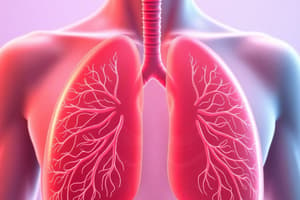Podcast
Questions and Answers
What is the primary function of the lung?
What is the primary function of the lung?
- To produce red blood cells
- To facilitate the exchange of oxygen and carbon dioxide (correct)
- To regulate body temperature
- To store excess oxygen
Where does gas exchange primarily occur in the lung?
Where does gas exchange primarily occur in the lung?
- Alveoli (correct)
- Bronchi
- Trachea
- Diaphragm
What does lung capacity refer to?
What does lung capacity refer to?
- The size of the trachea
- The amount of air a person can breathe in and out during a single breath (correct)
- The number of lobes in the lungs
- The color of the lungs
Which test is commonly used to measure how much air a person can breathe in and out?
Which test is commonly used to measure how much air a person can breathe in and out?
What does tidal volume refer to in lung volume measurements?
What does tidal volume refer to in lung volume measurements?
How is lung elasticity essential for breathing?
How is lung elasticity essential for breathing?
What is functional residual capacity in lung volume measurements?
What is functional residual capacity in lung volume measurements?
Which lung condition affects lung function negatively?
Which lung condition affects lung function negatively?
What is the potential impact of technology on lung function testing in the future?
What is the potential impact of technology on lung function testing in the future?
Why are lung volume measurements crucial for understanding respiratory health?
Why are lung volume measurements crucial for understanding respiratory health?
Flashcards are hidden until you start studying
Study Notes
Unraveling Lung Function: A Deeper Dive
The human respiratory system is a marvel of engineering, allowing us to breathe, exchange gases, and maintain our life-sustaining chemical balance. A central component of this system is the lung, where gas exchange occurs with remarkable efficiency and precision. To appreciate the wonders of lung function, let's explore the intricacies of this vital organ.
Gas Exchange
The primary function of the lung is to facilitate the exchange of oxygen and carbon dioxide between the body and the atmosphere. This process takes place in the alveoli, tiny air sacs that come in close proximity to blood capillaries. Oxygen from the air diffuses into the bloodstream, while carbon dioxide, a waste product, moves in the opposite direction.
Lung Capacity
The lung's ability to expand and contract enables it to trap air and facilitate gas exchange. Lung capacity refers to the amount of air a person can breathe in and out during a single breath. This measurement provides valuable information about respiratory health.
Lung Function Tests
Clinicians use lung function tests to assess the health of a patient's respiratory system. Some common tests include spirometry, which measures how much air a person can breathe in and out, and lung volume tests, which evaluate the lung's capacity. These tests are essential in the diagnosis and monitoring of respiratory conditions.
Lung Volume Measurements
Lung volume measurements categorize lung function into specific areas:
- Tidal volume: The volume of air inhaled and exhaled during normal breathing.
- Residual volume: The amount of air remaining in the lungs after a complete exhalation.
- Inspiratory capacity: The maximum amount of air inhaled after a normal exhalation.
- Vital capacity: The maximum amount of air exhaled after a maximum inhalation.
- Functional residual capacity: The volume of air remaining in the lungs after a normal exhalation.
These measurements are crucial in understanding lung function and diagnosing respiratory conditions such as asthma, chronic obstructive pulmonary disease (COPD), and pulmonary fibrosis.
Lung Mechanics
The lung relies on elasticity and surface tension to expand and contract. Elasticity allows the lung to return to its original shape after inhalation, while surface tension acts as a force that tends to collapse the lung. The interaction between these two forces creates the lung's unique ability to breathe.
Lung Diseases and Conditions
Respiratory conditions such as asthma, COPD, pulmonary fibrosis, lung cancer, and sleep apnea negatively affect lung function. Early detection, proper diagnosis, and appropriate treatments are essential in managing these conditions and preserving lung health.
The Future of Lung Function Testing
Researchers and physicians continue to explore novel ways to assess lung function. For example, Bing Chat has announced a feature that allows users to opt-out of web searches, potentially speeding up the delivery of information and reducing the need for complex lung function tests. In the future, technology may enhance and simplify the diagnosis and monitoring of respiratory conditions, ultimately improving patient care.
In summary, the human lung is a remarkable organ that enables us to breathe and maintain our overall health. Lung function tests and measurements give us valuable insights into our respiratory health and the potential for early detection and treatment of respiratory conditions. As technology advances, we may see the development of new tools to improve lung function testing and patient care.
Studying That Suits You
Use AI to generate personalized quizzes and flashcards to suit your learning preferences.




